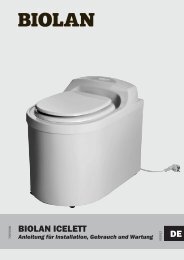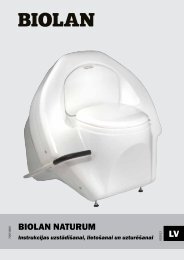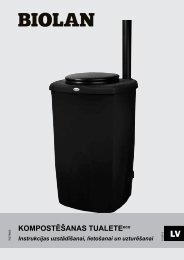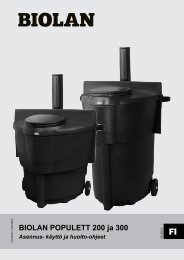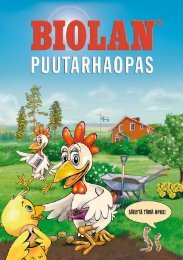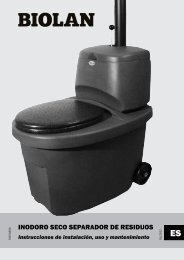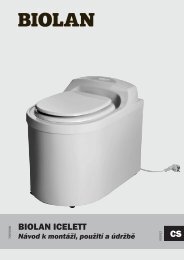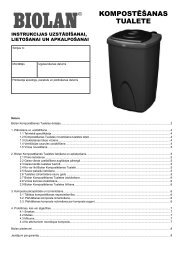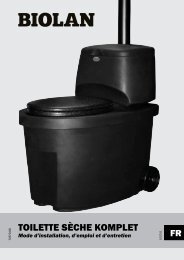SEPARATING DRY TOILET - Biolan
SEPARATING DRY TOILET - Biolan
SEPARATING DRY TOILET - Biolan
- No tags were found...
You also want an ePaper? Increase the reach of your titles
YUMPU automatically turns print PDFs into web optimized ePapers that Google loves.
70570300<strong>SEPARATING</strong> <strong>DRY</strong> <strong>TOILET</strong>Instructions for installation, use and maintenance01/2012EN1
<strong>SEPARATING</strong> <strong>DRY</strong> <strong>TOILET</strong>Instructions for installation, use and maintenanceThe <strong>Biolan</strong> Separating Dry Toilet is a toilet unit to be placedeither indoors on the floor surface or in a separate toiletbuilding. The Separating Dry Toilet operates by separatingsolid and liquid waste matter in the seat part of theunit. The toilet requires neither water nor electricitysupply.ContentsComponent listEN-21. Planning and installation EN-31.1 Placing the Separating Dry Toilet in the toilet space EN-31.2 Installing the ventilation pipe EN-31.3 Conducting the liquid away after separation EN-32. Use and maintenance of the <strong>Biolan</strong> Separating Dry Toilet EN-42.1 Before use EN-42.2 Using bulking material EN-42.3 Year-round use of the toilet EN-42.4 Emptying the inner receptacle EN-42.5 Emptying the liquid tank EN-52.6 Cleaning the Separating Dry Toilet EN-53. Problems that may occur EN-53.1 Odours and moisture EN-53.2 Insects EN-54. Composting the toilet waste EN-55. Utilisation of liquid EN-56. Disposal of the product EN-5<strong>Biolan</strong> accessoriesEN-6About the guaranteeEN-6ENDimensionslengthwidthsitting heightheightheight to the batcher's knobweightvolume of the bulking material containersize of the inner receptaclediameter of the ventilation pipelength of the ventilation pipelength of the ventilation pipediameter of the liquid removal pipe78 cm59.4 cm53 cm85 cm98.5 cmabout 16 kg30 litres28 litres75 mm750 mm600 mm32 mmEN-1
Component listComponent Part name Part No. Material1 Toilet tank, blue or 17703010 PE1 Toilet tank, white 17742010 PE2 Lid, blue or 17703020 PE2 Lid, white 17742020 PE91184273 Bulking material container, blue or 17703030 PE3 Bulking material container, white 17742030 PE4 Cover for the container, blue or 17703040 PE4 Cover for the container, white 17742040 PE5 Inner receptacle 18703050 PE71412133206 Cover for inner receptacle 18703060 PE* Batcher assembled 18703900107 Batcher spring Steel8 Batcher rod Steel9 Rod washer Steel152610 Rod nut Steel11 Batcher knob PE12 Attachment screw for batcher, 3 pcs. Steel22013 Batcher frame PE14 Batcher plug PE15 Batcher sheet PE16 Drain pipe, black or 28578001 PE17181616 Drain pipe, white 28578000 PE17 Liquid funnel 18703180 PE18 Guide plate 18703280 PE19 Flexible ventilation pipe, black or 19704020 PVC +steel19 Flexible ventilation pipe, white 19704025 PE65221920 Ventilation pipe 750 mm 28704030 PE20 Ventilation pipe 750 mm white, without 28704035 PEjoint sleeve21 Ventilation pipe 600 mm, black or 28704040 PE2125EN21 Ventilation pipe 600 mm, white 28704045 PE22 Pipe bracket, black or 18704050 PE22 Pipe bracket, white 18704055 PE1232423 Wheel 18704060 PE24 Lock ring 20070003 Steel25 Rod 21704190 Steel26 Pehvakka (in Finland) 70578500 PPE26 White seat lid (abroad) 18700001 PE27 Ventilation pipe cap 18710250 PEIn addition to the components illustrated in the componentspicture, the package includes:User manual Finnish/Swedish 27703170 PaperUser manual in 10 languages (export productsonly)27703175 PaperThe white toilet unit further includes:Joint sleeve for the ventilation pipe, white 28575030 PEThe ready-assembled batcher includes components:7.8, 9, 10, 11, 12, 13, 14 and 15EN-2
1. Planning and installationWhen selecting a location for, and then installing, the <strong>Biolan</strong> SeparatingDry Toilet, make sure to allow sufficient space for its use andmaintenance, and route the ventilation pipe straight up through theroof above the ridge. Collect the liquid in a closed tank for later use,treat it together with other wastewater from the property, or take it tothe wastewater treatment plant. When dimensioning the liquid tankand deciding where to locate it, you need to take into account thatthe daily amount of liquid from the separating toilet is 1-1,5 litres peruser. The method for post-treating the solid waste should also becarefully planned, to enable easier servicing of the unit.Technical specifications--length 78 cm, width 59.4 cm--sitting height 53 cm--height 85 cm, 98.5 cm to the batcher's knob--weight about 16 kg--inner receptacle 28 l, 2 pcs.--external diameter of the ventilation pipe 75 mm--external diameter of the liquid removal pipe 32 mmInstallation exampleThe picture is indicative only1.1 Placing the Separating Dry Toilet in thetoilet spaceInstall the Separating Dry Toilet at a level position on the floor. Whendeciding where to locate the unit, take into account the space requiredfor its ventilation and liquid removal arrangements, and forits maintenance.1.2 Installing the ventilation pipeRoute the ventilation pipe from the toilet unit straight up over theroof ridge. Any bends in the pipe will impede natural ventilation,causing odour problems. Join up the ventilation pipe as shown inthe detail drawing (page 2), and seal the pipe using a sealant suitablefor the roofing material. As required, extend the ventilation pipewith a Ø 75-mm sewer pipe, or with the pipe parts that are sold asspare parts for the toilet.In complicated installations, or if installing the toilet within livingquarters, it is recommended that the ventilation be ensured usinga separate <strong>Biolan</strong> Exhaust Ventilator or <strong>Biolan</strong> Wind Fan. You canobtain the Exhaust Ventilator either as an option, or retro-fit it if itproves necessary (see Accessories on page EN-6).The flexible ventilation pipe (part 19) is easiest to installwhen warm, using a screwdriver as a stretching aid. Asnecessary, the surfaces can be made slippery using, forexample, dishwashing detergent.EN1.3 Conducting the liquid away after separationRoute the liquid after separation from the toilet unit into either theliquid tank or the sewer system. During installation, provide sufficientgradient to enable the liquid to flow without obstruction all theway to the drain.Depending on the installation location, accomplish the lead-througheither as a sewer or as a pipe leading through the wall or the floor.The diameter of the toilet unit liquid hose is 32 mm. Sewer pipeparts or a hose 32 mm in diameter are suitable for conducting theliquid away. We recommend using a coupling sleeve at the pipe orhose joint.The toilet unit has no drain trap. If the liquid is routed into a tank,the hose must extend all the way to the bottom, in which case thesurface of the liquid in the tank makes a drain trap in the hose. Thusthe air cannot flow from the liquid tank back to the toilet unit. Thetank must be provided with either a pressure relief valve or someother way for the replacement air.If you intend to route the liquid to the sewer system, your plan shouldexplicitly take into account the ventilation of the sewer system andthe toilet space.EN-3
EN2. Use and maintenance of the <strong>Biolan</strong>Separating Dry ToiletUsing and maintaining the Separating Dry Toilet in accordance withthese instructions makes for a much more pleasant experience.Separation of the liquid and the solid waste requires that the SeparatingDry Toilet always be used in the seated position. When usingthe unit for the first few times, verify that your own seating distanceand habits are suitable for it. Also instruct your guests on how thetoilet should be used.The Separating Dry Toilet is intended for composting toilet waste, includingtoilet paper. But do not put into it anything that could hamperthe treatment of the waste, such as:• debris, sanitary towels• chemicals, lime• detergents, washing water• matches, ash, cigarette butts2.1 Before usePut a layer of <strong>Biolan</strong> Compost and Toilet Bulking Material a coupleof centimetres thick on the bottom of the foremost inner receptacle(part 5). Fill the bulking material container (part 3) with bulking material.2.2 Using bulking materialThere is a bulking material batcher in the bulking material containerat the rear of the toilet unit. To use the batcher, press the batcherknob (Fig. 1) briskly. The more briskly you press this knob, the fartherthe bulking material will be thrown. The bulking material doesnot need to be added every time the toilet is used; adding it onlyafter defecation is sufficient.Applying suitable bulking material is essential for proper operationof the toilet. For bedding we recommend <strong>Biolan</strong> Compost and ToiletBulking Material or <strong>Biolan</strong> Peat (see Accessories on page EN-6).2.3 Year-round use of the toiletThe toilet may be used all year round, if installed in a warm space.Thermal insulation of the ventilation and liquid removal systems incold areas must then, however, be taken into account. Also providea sufficient gradient to prevent the liquid from freezing in the pipe.Installed in a cold space, the toilet can freeze during winter. Thetoilet unit is manufactured of frost-proof polyethylene, so freezingdoes not damage it. A toilet located in a cold space can be usedoccasionally during winter. Empty the liquid tank before the liquidin it freezes.If the liquid is collected in a canister, empty the canister in the autumnin order to avoid damage caused by freezing of the liquid. Ifthe bulking material in the container is moist, it may freeze duringwinter. Then the bulking material batcher does not work and youmust apply the bulking material manually.2.4 Emptying the inner receptacleThere are two separate inner receptacles inside the tank of the SeparatingDry Toilet (Fig. 2). Use only one receptacle at a time. Whena receptacle fills up, move it to the back of the unit and put the otherreceptacle into use. As required, level the surface of the waste, forexample, with a stick.The covers for the inner receptacles are intended for use whiletransporting the receptacles for emptying. Leave the lid ajar for storing.Once both receptacles have filled up, empty the one that filledup first into the compost. Disconnect the ventilation pipe (Part 21)from the lid of the toilet for emptying (Fig. 3). The flexible ventilationpipe will flex at this stage so that you will be able to lift the pipe.Tilt the lid of the toilet unit to the side or lift it off, so that you can liftthe receptacles out of the unit. There is no need to wash the innerreceptacles when emptying them.When replacing the receptacles, make sure to position the receptaclein use correctly against the separating bowl. Put a layer of<strong>Biolan</strong> Compost and Toilet Bulking Material or <strong>Biolan</strong> Peat a coupleof centimetres thick onto the bottom of the receptacle. Refer to pageEN-5 for instructions for composting the solid waste from the SeparatingDry Toilet.1. Batcher knob2. Inner receptaclesEN-43. Disconnecting the ventilation pipe.
2.5 Emptying the liquid tankEmpty the liquid tank, if necessary. The emptying intervals are determinedby the size of the liquid tank and by how often the toilet isbeing used. One person produces 1-1,5 litres of liquid daily.Utilise the liquid that is rich in nutrients, in particular nitrogen, asfertiliser in the yard and garden. Although urine is sterile, it is recommendedto keep it in storage for about three months before using itin the garden.You can use a small amount of undiluted liquid as a source of nitrogenfor the garden compost and for the compost of separated toiletwaste. Optionally, you can take the liquid to the wastewater treatmentplant. More about the utilisation of urine on page EN-5.2.6 Cleaning the Separating Dry ToiletWash and clean the Separating Dry Toilet, as necessary. Any commonlyavailable domestic cleaning agents may be used. You candisassemble the parts of the toilet to enable proper cleaning of theunit. Wash the liquid bowl in the top, the liquid funnel (part 17) andthe drain pipe (part 16) with warm water and mild detergent or crystallisedsodium at least once a year to remove any precipitate thatthe urine may have formed.3. Problems that may occur3.1 Odours and moistureNo odour problems occur in the Separating Dry Toilet provided thatit is installed and used in the correct manner. If odour problems occur,check that:• there is no liquid on the bottom of the toilet tank (part 1). If liquidexists, check the removal hose connection for tightness andwash the tank to eliminate the odour. Make sure that the foremostinner receptacle is correctly positioned against the rim ofthe separating bowl.• make sure that the ventilation pipe leading from the toilet unitto the roof, is straight and extends above the roof ridge. If theventilation pipe is not straight or does not extend above the roofridge, you can repair the installation or improve the ventilation byinstalling a separate <strong>Biolan</strong> Exhaust Ventilator or a <strong>Biolan</strong> WindFan (see Accessories on page EN-6).• the hose leading to the liquid canister extends to the bottom ofthe canister. This ensures that the surface of the liquid in thecanister forms a drain trap in the hose, preventing air-flow fromthe canister towards the liquid bowl.• the waste in the inner receptacles is always covered with <strong>Biolan</strong>Compost and Toilet Bulking Material or <strong>Biolan</strong> Peat.3.2 InsectsInsects do not normally exist in the Separating Dry Toilet. But if flies,for example, appear in the toilet unit, empty both receptacles into acompost and then wash them. Do away with any flying insects in thetoilet space, using pyrethrin-based spray. Consult your local gardencentre to select a suitable product.Also check that:• the waste in the inner receptacles is always covered with <strong>Biolan</strong>Compost and Toilet Bulking Material.• the ventilation pipe leading from the toilet unit to the roof, goesstraight up and extends above the roof ridge. If the ventilationpipe does not go straight up or does not extend above the roofridge, repair the installation or improve the ventilation by installinga separate <strong>Biolan</strong> Exhaust Ventilator or a <strong>Biolan</strong> Wind Fan(see Accessories on page EN-6).The micro-organisms in the compost decompose organic matter underaerobic conditions. After the composting has continued for 1–3years the result will be compost soil.To ensure that the composting is as efficient as possible, providethe waste-decomposing micro-organisms with favourable living conditions.The basic requirements for compost are the presence ofoxygen, moisture and nutrients.The micro-organisms in the compost require moist conditions, sothe compost must be suitably moist, but not wet. The solid wastefrom the Separating Dry Toilet is relatively dry and also poor in nitrogencompared with the Dry Toilet where urine and solid matterare placed into the same tank. Therefore, dampen the compost withwater, or with separated urine which provides the compost with agood source of nitrogen supplement.To ensure that the compost is sufficiently airy, use coarse bulkingmaterial or branch chaff in layers among the waste. Compost that istoo tightly packed or too wet is anaerobic and starts to rot and smell.Cover the surface of the compost carefully with bulking material,garden waste or peat after the addition of toilet waste or liquid. Turnthe compost at least once during the summer to ensure that allthe ingredients of the compost decompose properly. Toilet waste,composted with care, makes excellent soil conditioner for perennialplants, shrubs, trees and a vegetable plot.5. Utilisation of liquidSeparated liquid can be utilised as nitrogen fertiliser or diluted withwater, for example, for lawns, ornamental bushes and perennialplants. In the spring, in connection with the initial fertilisation, it canalso be used for a vegetable plot but during the growing season itmust not be applied to green vegetables. The recommended storagetime for urine is about three months before it should be used inthe garden. Do not apply urine to plants in the autumn, in order toavoid disturbing the perennials' preparation for winter.A safe dilution ratio for urine is 1:5, which means one litre is dilutedwith five litres of water. You can also use undiluted urine, but thenyou must water the area carefully after the application to avoid earlyblight. Carry out the application when it is cloudy, either early in themorning or late in the evening, when evaporation of nitrogen andthe odour-related problems are at a minimum. During the growingseason you can apply 1-1,5 l/m² of undiluted urine in your homegarden.Please consult your local waste advisor for regulations on composting.Visit www.biolan.fi for more information on composting and theutilisation of urine.Do not allow liquids that are rich in nutrients to enterthe soil, as these cause an excessively concentratednutrient load.6. Disposal of the productThe raw materials used are presented in the list (see page 4) Disposeof each part as prescribed. Always follow the regional andcollecting-point-specific instructions.EN4. Composting the toilet wasteWaste emptied from the Separating Dry Toilet always requirescomposting before it can be utilised. You can compost the toiletwaste together with garden waste and domestic bio-waste. Whilecomposting, make sure to observe the local regulations on wastehandling, and consider sufficient protective distances to neighbours,wells and nearby bodies of water.Organise the composting so that no liquids seep from the compostinto the soil. The <strong>Biolan</strong> Garden Composter or the <strong>Biolan</strong> StoneComposter (see Accessories on page 8) is well-suited to the purpose.For hygienic reasons, compost the toilet waste for at least ayear before applying it to edible plants. Composting for half a year issufficient before application to ornamental plants. Burying waste inthe ground is prohibited.02PE-HD05PPPE = polyethyleneto energy-from-waste process or recycling of plasticPP = polypropyleneto energy-from-waste process or recycling of plasticRST = stainless steelto recycling of metalPaperto recycling of paperEN-5
<strong>Biolan</strong> accessoriesEN<strong>Biolan</strong> Compost and ToiletBulking Material<strong>Biolan</strong> Compost and Toilet Bulking Material isa blend made of pure, dried and ground coniferbark and peat for composting and dry toilets.Applying it regularly to the compost keeps thecompost mass airy and ensures the compostingis efficient and odourless.Package size: a bag of 40 litres, a bag of 85 litresProduct number: 40 l 70562100, 85 l 70562500<strong>Biolan</strong> Peat<strong>Biolan</strong> Peat is clean, white non-fertilised or limedsphagnum peat. It is naturally sour. <strong>Biolan</strong> Peatis suitable for, for example, storing root crop, useas soil conditioner, and use in an evaporatingpan for seep liquid.Package size: a bag of 70 litresProduct number: 55544200<strong>Biolan</strong> Biowaste Bag 40A biodegradable bag to be placed in the inner receptacle of the toilet,which can be composted. Capacity about 40 litres Roll of 30bagsProduct number: 707722001<strong>Biolan</strong> Pehvakka<strong>Biolan</strong> Pehvakka is a hinged thermal seat,which is hygienic and durable. The flexiblefoam material neither cracks in use nor absorbsmoisture. Both the lid and the seat ring can belifted up, which makes thorough cleaning of theseat easier. It can be cleaned using any commondomestic cleaning agents. The seat canbe fitted in toilets where the distance betweenthe hinge pins is either 16 cm or 18 cm.Product number: 70578500<strong>Biolan</strong> Wind FanThe <strong>Biolan</strong> Wind Fan is an efficient exhaustfan that is powered by the wind. It is ideal forimproving the ventilation in warehouses, drytoilets, bathrooms, small scale water treatmentplants etc, and locations that need good ventilation.The Wind Fan is made of aluminium,and thanks to its very mobile bearing, even aslight breeze can improve ventilation significantly.Product number: 70572500<strong>Biolan</strong> Exhaust VentilatorThe Exhaust Ventilator with electric drive isdesigned to improve the ventilation of the drytoilet. The connectors of the Exhaust Ventilatorfit directly to a pipe 75 mm in diameter. Theventilator only requires electric power of about10 W. The ventilator operates with a voltage of12 V and its rotational speed can be adjustedusing the transformer included in the package.Product number: black 70575410,white 705420<strong>Biolan</strong> Garden ComposterThe <strong>Biolan</strong> Garden Composter is intendedfor the composting of domestic, gardenand toilet waste in a detached house ora holiday home. Its large, hinged covermakes the filling of the composter easier.The hermetic structure and adjustable airexchange prevent the compost mass fromdrying, and reduce the need for maintenance.Product number: green 70572000, grey 70576700<strong>Biolan</strong> Stone ComposterThe <strong>Biolan</strong> Stone Composter is intendedfor the composting of domestic and gardenwaste in a detached house or holidayhome. Thanks to its large size, it is wellsuitedto the composting of garden wasteand toilet waste from a summer cottage.<strong>Biolan</strong> Stone Composter having the colourof natural stone merges well with its surroundings,and is well-suited even to smallyards.Product number: red granite 70573100, grey granite 70573200About the guaranteeThe <strong>Biolan</strong> Separating Dry Toilet is guaranteed for one year.1. The guarantee is valid from the date of purchase and covers possibledefects in material and workmanship. The guarantee doesnot cover any indirect damage.2. <strong>Biolan</strong> Oy retains the right to decide about repairing or replacingdamaged parts at its discretion.3. Any damage resulting from careless or forcible handling of thedevice – from failure to observe the operating instructions, orfrom normal wear – will not be covered by this guarantee.For matters related to the guarantee, please consult <strong>Biolan</strong> Oy directly.EN-6<strong>Biolan</strong> OyP.O. Box 2, FI-27501 KAUTTUATel. +358 2 5491 600Fax +358 2 5491 660www.biolan.fi



